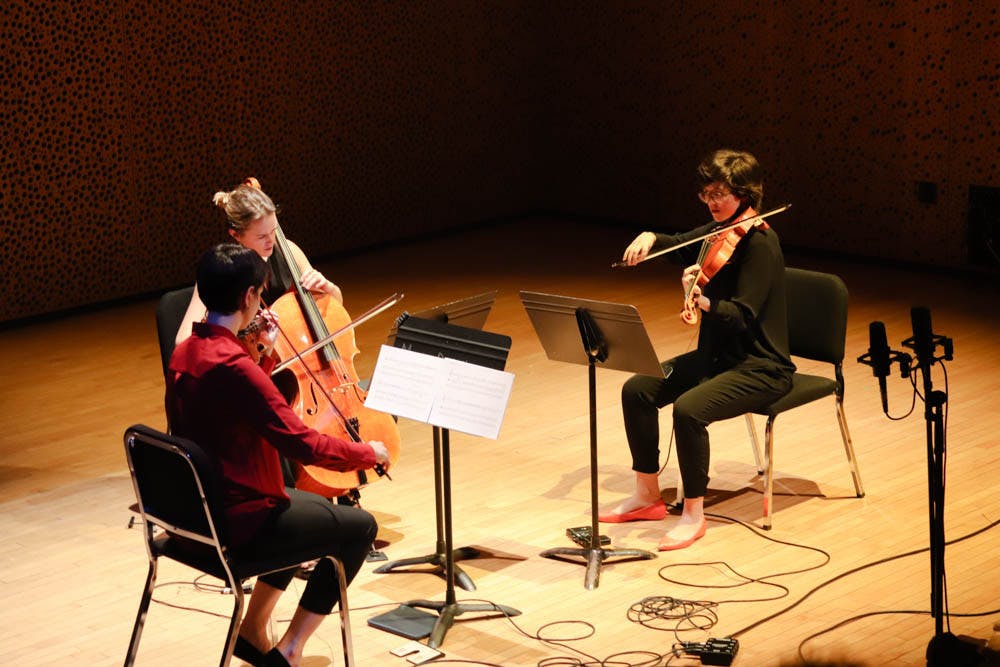The Chartreuse string trio performed contemporary and experimental music in a concert Tuesday night, playing compositions from their usual repertoire as well as new pieces composed by University students.
The trio — violinist Myra Hinrichs, violist Carrie Frey and cellist Helen Newby — pushed the conventional limits of each instrument’s sound. Some pieces they played incorporated electronic components, while others explored the physical possibilities of the instruments themselves, such as the muted, breath-like effect created by the ponticello technique.
Kristina Warren, visiting assistant professor of music, brought Chartreuse to the University after having collaborated with the trio in the past. “I try to bring people who are doing really fantastic work and might be a little afield relative to a lot of peoples’ normal listening experience,” Warren said.
Chartreuse played Warren’s “the chance that time takes,” a piece she originally wrote for a quartet but transposed for the trio. Her work exhibits thought and care for the social questions that arise alongside music, calling attention to the power dynamics that exist between the different roles involved in performance. “I’m trying to highlight that a great deal of collaboration goes into the composition process,” she said.
Her piece for Chartreuse is no exception, its score including some specific performance instructions while still leaving creative freedom for the musicians. “I was really interested in exploring, nuancing, varying the relationship between composer, performer and listener — somehow subverting, upsetting the power hierarchies I see implicit there,” Warren said.
Marcel Zaes GS composed “Texture B” for Chartreuse with similar intentions in mind. In the piece, Zaes tried to evoke a particular musical soundscape while allowing for improvisation. He too was wary of the social structures at play in performance, elaborating that his intention in “Texture B” was to do something distinctly different from the traditional.
Zaes explained that he did not see his work as a piece of music, but rather a single sheet of paper with a set of instructions, which were the only constraints provided for the musicians. In this instance, Zaes’s invitation to autonomy created a “very soft, very silent, very fragile carpet of sound, a stream that has no inner rhythm, that never stops,” he added.
During the performance of “Texture B,” the sound of the instruments was modified and reproduced with the use of software that cut the sound into fragments, creating “rhythm out of something where there wasn’t rhythm there before,” Zaes said. Both the uninterrupted sound and the fragmented version were simultaneously audible in the concert hall, resulting in textural depth within the same melody.
In a small, collaborative concert, “there is room to try an idea out that you normally wouldn’t … (something) that is radical in some way,” Zaes said.
Reid Merzbacher’s ’20 piece “Ebb and Flow” was an experiment in its own right. Rather than using electronic equipment, he utilized an exploratory rationale in deciding to compose for a solo violist. A violinist himself, he used the opportunity of Chartreuse’s concert “to write for this instrument that I neglect,” Merzbacher said.
Each composer had time to work with Chartreuse on the more subtle aspects of their pieces in the days leading up to the concert. “It was exciting to hear it come together,” Merzbacher said, adding that the performance was even better than the rehearsals. Leading up to the concert, the members of Chartreuse expressed interest and enthusiasm as they learned new compositions and braved a hot rehearsal hall.
The trio is accustomed to taking on such challenges, as they have previous experience with experimental works of music. Frey, the trio’s violist, spoke about adjusting to new methods of musical notation, like that of Zae’s score. “It’s always neat when you see something and you’re like, ‘Oh yeah, I’ve never seen anything else like this.’ But it’s very intuitive and really conveys what the music will sound like,” she said.
In addition to works by composers on campus, Chartreuse played pieces from their previous repertoire, the content of which is determined by the group’s shared musical taste. Frey said the pieces they like to play “have to be fun, they have to sound good and we have to like the composer.” She explained that these criteria define the sound of their group.





